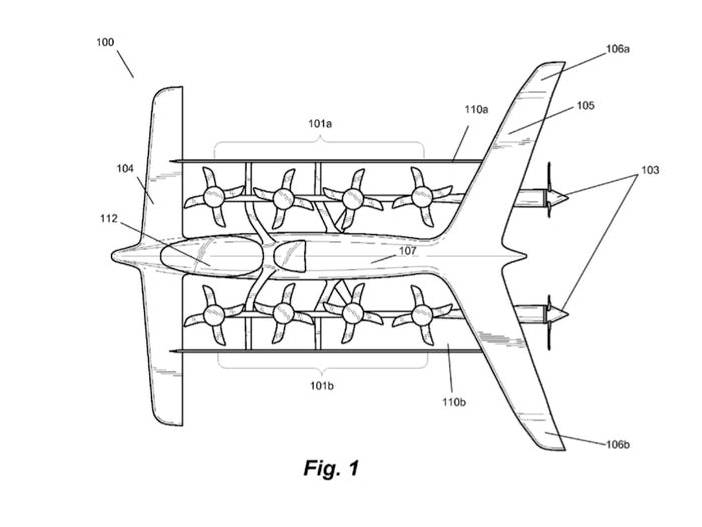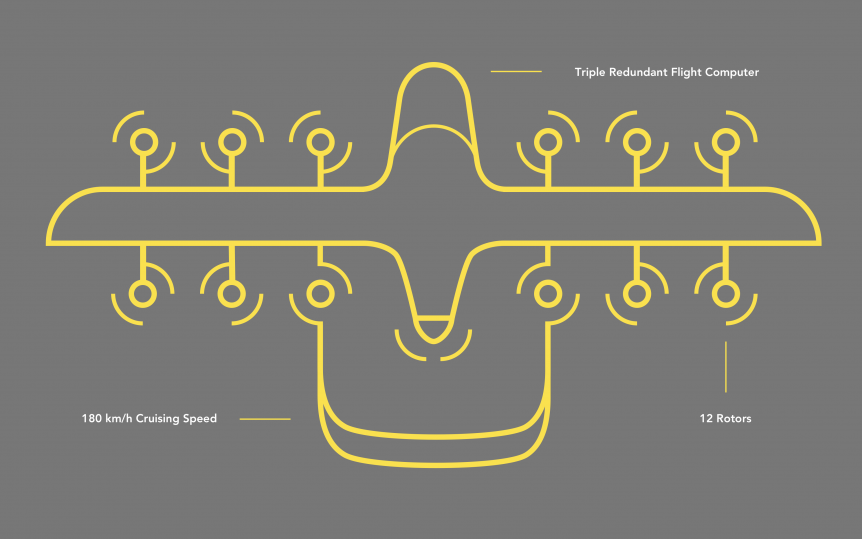While Eviation’s Alice is drawing adulation for its initial test flight, Kittyhawk, a one-time front-runner and pioneer is quietly closing down. A vision of Larry Page, Sebastian Thrun, and Ilan Kroo, Kittyhawk brought us several approaches to personal green flight, with a heavy emphasis on intuitive control and automated flight. One of its many approaches lives on, though, through sister company Wisk. Blooper Reel Kittyhawk’s earlier efforts look somewhat like an aeronautical blooper reel, one of those montages of early flying machines that evoke laughs when shown as preludes to more serious stuff in movie theaters. Kittyhawk, though, avoided crashes and humiliation. The firm explains its history: “Kittyhawk was founded in 2010 by autonomous car pioneer Sebastian Thrun with the backing of Google co-founder Larry Page to explore the frontier of then-new eVTOL aviation.” From Zee to Kittyhawk Originally founded as Zee Aviation, Kittyhawk was secretive, with only glimpses of its potential aerial vehicles surfacing as “spy shots.” The ZP-1 …
Wisk Tests Cora in US, New Zealand
Recently renamed Wisk (formerly KittyHawk) has resumed flight testing of its Cora eVTOL (electric Vertical Take Off and Landing) machines following a cautionary corona virus shutdown. It’s already got a fleet, with several prototypes in the U. S. and at least four in New Zealand. New Zealand seems to have a lock on flight testing for unpiloted aircraft, with Pyka and Cora both finding amenable administrators willing to allow flight tests. Boeing and Wisk are collaborating on achieving urban air mobility with the two-seat machine, and getting a lot of positive vibes from the locals. Partly from the NZ government, partly from local businesses, and partly from indigenous Maori tribes’ people, Wisk and Cora have found wide-spread acceptance down under. Government Support Research, Science and Innovation Minister Megan Woods announced last October that, “The Government is establishing an Airspace Integration Trials Program to support the safe testing and development of advanced unmanned aircraft and accelerate their integration into the aviation …
UAM Realization May be Closer than We Think
We are on the verge of big happenings in the Urban Air Mobility (UAM) world. Large amounts of money are flowing into the coffers of those companies which dared to pioneer in the area. Large firms are partnering with these aerial startups. And the Federal Aeronautics Administration is paying attention while actively pursuing certification for the new machines headed our way. Jay Merkle, FAA Certification and Airspace Integration At the Transportation Review Board’s annual meeting in Orlando, Florida, Jay Merkle, head of the FAA’s UAS integration office, told attendees that six (Urban Air Mobility) UAM vehicles are “well along,” according to a report in Aviation Today. He held that the growing market is ““more than just hype … this is more than just promotional videos.” Merkle apparently feels current regulations such as FAR Part 23 are adequate to help these new electric Vertical Take Off and Landing (eVTOL) machines be certified. Merkle feels the machines in progress can provide service …
GoFly Announces First Round Prize Winners
Boeing just announced the ten winners of Phase I in its GoFly competition, in which entrants design, build and fly a “personal flying device.” As Boeing explains, contest rules are designed to enable entrants “To foster the development of safe, quiet, ultra-compact, near-VTOL personal flying devices capable of flying twenty miles while carrying a single person.” The list of partners and co-sponsors is impressive and includes virtually all major American aviation advocacy groups. As the Green Flight Challenge demonstrated seven years ago, prize money encourages a grand series of investments by individuals in hopes of winning a prize. In this case, 3,000 entries by 725 teams from 95 countries presented drawings and documents describing their proposed PFD, with a select 10 advancing to Phase II, which will require a demonstration of the proposed machine’s ability to perform as promised. “To be able to engage so many individuals from leading universities, major corporations and startups, and connect them through our community …
Kitty Hawk Flyer Shows Improvements, Limits Continue
Kitty Hawk Flyer, the Larry Page-backed “sky taxi,” seems like a great summer escape machine. One can learn to fly it in about an hour, but it will remain low and slow enough to give the thrill of flight without inordinate dangers. That’s the marketing pitch from Kitty Hawk, and it’s not a bad one. Imagine going to a beach or lake with dozens of these fluttering about over the water’s surface. It’s the same kind of lure driving go-karts on a miniature race course has for vacationers. Safety is obviously a factor for a machine meant for amateur use. John Lyon explains this in the Robb Report: “The zero-emissions Flyer is completely powered by electricity, and its propellers all operate independently, meaning that if there is a problem with one or more propellers, the entire vehicle won’t come crashing down. That said, even if it did, the aircraft is only meant for flying over water and only flies between …
Zee? Kitty Hawk? Cora?
Different Names, Different Configurations Zee, One of two aircraft companies funded by Google founder and CEO Larry Page, has been a highly mysterious business. Its web pages mostly gave discrete job descriptions for those willing to sign up for a mostly undefined mission. Occasional glimpses of patent drawings, spy shots of a multi-rotor craft in Google’s Mountain View, California parking lot came into view, and later, in-flight shots of other, different looking craft came from Hollister, California. Kitty Hawk, the other company funded by Larry Page, seems to have subsumed Zee and produced a 12-rotor, single-propeller aerial taxi about the size of a Cessna 150, but capable of vertical takeoffs and landings and seamless transitions to forward flight. A white example has flown at Hollister airport and a yellow version at a field in New Zealand. An Almost Epic Journey The intellectual, physical and geographical journey of this craft is almost epic, and seems to have resulted in a 13-motored …
Zeppelins, Blimps and Plimps
How about exploring a softer, gentler form of flight? Certainly, gas-filled envelopes provide a large way to transport goods and people, but for a variety of reasons, have fallen out of favor in recent years. Several entrepreneurs are trying to revive an old idea. Hanging Over Our Heads One threat hanging over our heads is that of plummeting drones, either having exhausted their short-range batteries or banging up against a tall building. The infamous video of a drone falling onto a woman in Seattle has been removed from YouTube, probably for legal reasons, but an abundance of others are there for your viewing pleasure. Maybe More Truth than Poetry Alfred Lord Tennyson wrote a prescient bit of poetry in 1835, envisioning future flight into an age where Amazon might be using electric blimps to deliver necessities and frivolities worldwide. For I dipt into the future, far as human eye could see, Saw the Vision of the world, and all the …
Larry Page and his Water-Skimming “Flying Car”
What’s the definition of a “flying car?” Does it need four wheels and quick-deploying wings to meet the definition? Engineers at Kitty Hawk, a Larry Page-funded company, showed some major sales points for what looks to be an easy-to-fly, somewhat whimsical electrically-driven octorotor. The Verge reports that, “Kitty Hawk promises people will be able to learn to fly the Flyer “in minutes.” A consumer version will be available by the end of this year, the company says.” The New York Times was a bit whimsical in describing the machine. “Kitty Hawk’s flying car, if you insisted on calling it a “car,” looked like something Luke Skywalker would have built out of spare parts. It was an open-seated, 220-pound contraption with room for one person, powered by eight battery-powered propellers that howled as loudly as a speedboat.” It’s also very much a ground effects machine, built to be used over water, but apparently without the necessary poop on the poop deck …
Larry Page’s Flying Car(s)?
A3 backed by Airbus, EHang 184 from China, and Zee from Larry Page (head of Google) – Silicon Valley seems an unlikely source of aeronautical breakthroughs, but several entrepreneurial outings from Airbus, Chinese startups, and Zee.Aero, led by a secretive Larry Page, have interest growing. A pair of recent flights by Zee’s craft in Hollister, California have generated coverage – and speculation. Larry Page’s Two Companies It turns out Page has a second company, Kitty Hawk, taking yet another path toward electrified flying cars with something like a large quadcopter – not unlike the eHang 184. Neither Zee.Aero nor Kitty Hawk is affiliated with Google, both funded out of Page’s largesse. One theory is that his two companies, the first started by noted aerodynamicist Ilan Kroo and the second headed by Sebastian Thrun, will engage in a friendly competition to create the best device for future development. Considering the secrecy, or perhaps because of it, a few recent flights by …








